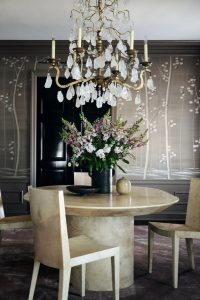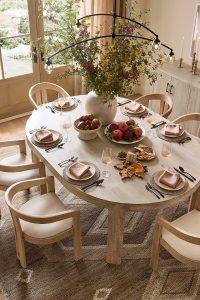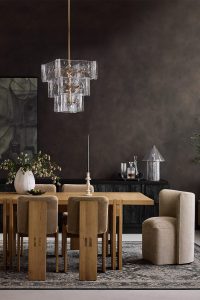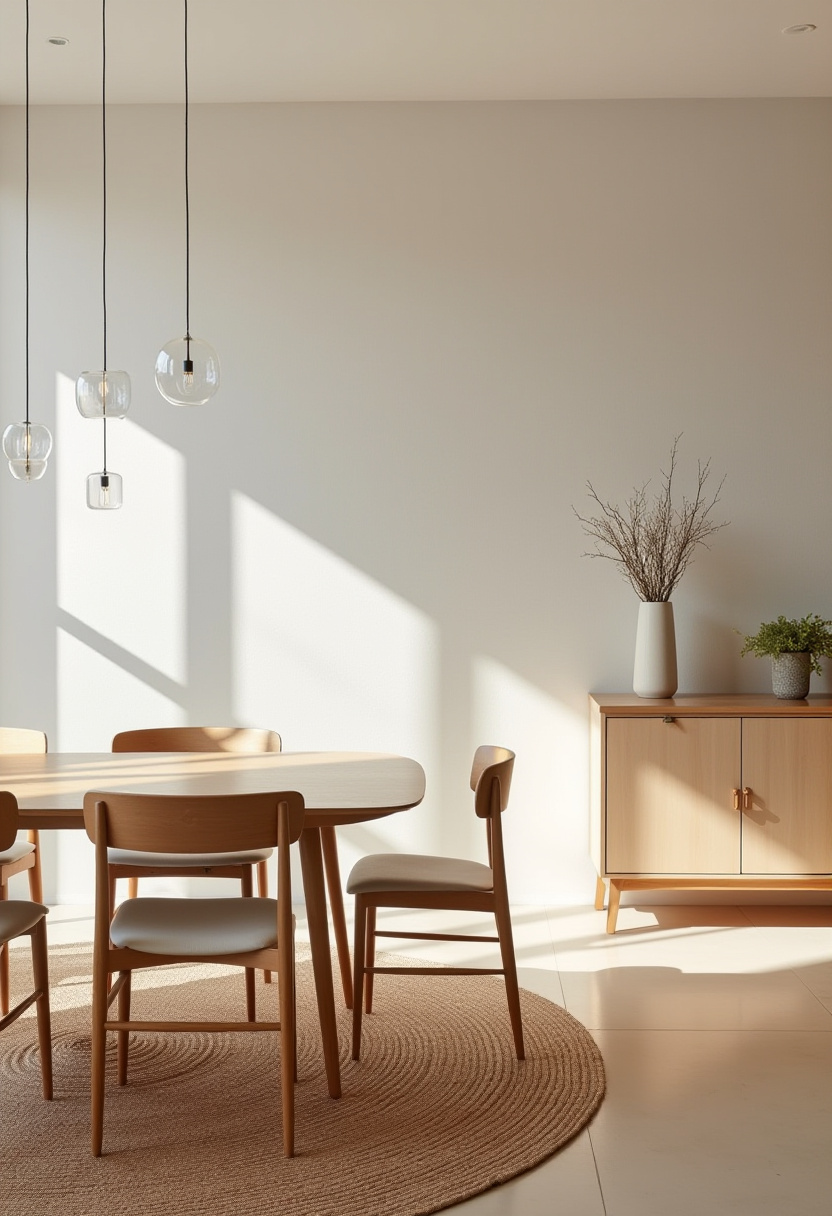
A dining room is more than a place to eat. It’s a space to talk, laugh, and spend time together. Simple design choices can bring style and comfort to any home. Today, people love blending ideas to make rooms calm and lovely. One trend that stands out is Japandi — a peaceful mix of Japanese simplicity and Scandinavian warmth. It feels relaxed, natural, and cozy. Here, we share Japandi dining ideas that mix beauty and function. Each room features soft light, smooth textures, and warm tones that make it calm and inviting. No matter the home size, Japandi style adds peace and balance to daily life.
1. Minimalist Oak Elegance

Step into a soft Japandi dining room that feels warm and peaceful. At the center stands a smooth oak table with simple wooden chairs. A low beige sideboard adds style and keeps the room feeling open. Sunlight flows through wide windows, lighting every surface with a gentle glow. A woven rug in light tones brings warmth and comfort under your feet. Soft colors of oak and beige create calm and balance. A ceramic vase or a small green plant adds a touch of life without clutter.
Choose a light oak table for a natural look.
Add simple chairs for clean design.
Use a low sideboard for extra space.
Keep tones soft and neutral for a cozy, calm feel.
2. Compact Urban Retreat
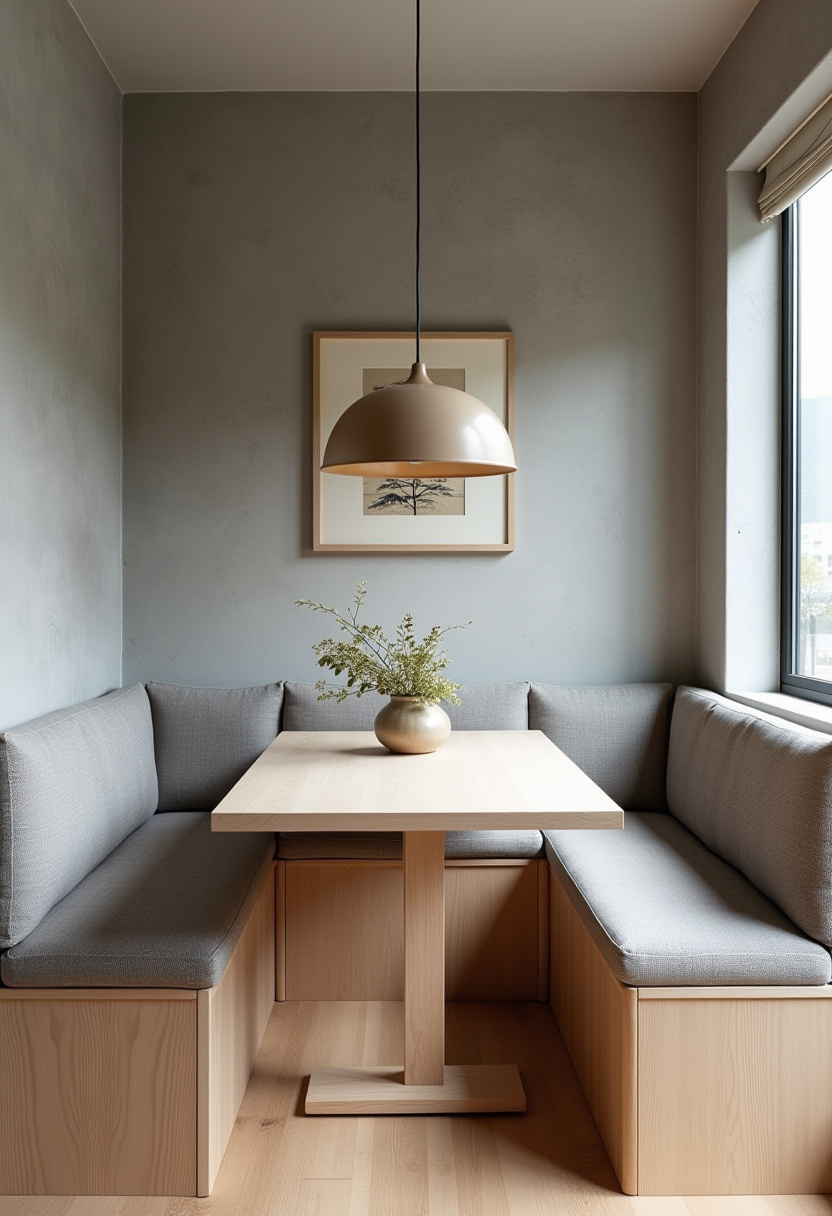
Step into a small Japandi dining room that feels calm and bright. A built-in bench saves space and adds a warm, cozy touch. In the center, a slim ash wood table gives the room balance and ease. Above, a ceramic light in soft earth tones glows gently. On the wall, simple gray art adds quiet beauty. This space shows how smart ideas make small rooms open and peaceful. The bench hides storage below while keeping the design neat and simple. Natural tones and soft light fill the room with comfort — perfect for relaxing or sharing meals with friends.
Choose built-in seating for comfort and extra space.
Pick a slim table to keep it open.
Use ceramic lights for warmth.
Hang simple art for a balanced, calm look.
3. Spacious Zen Retreat
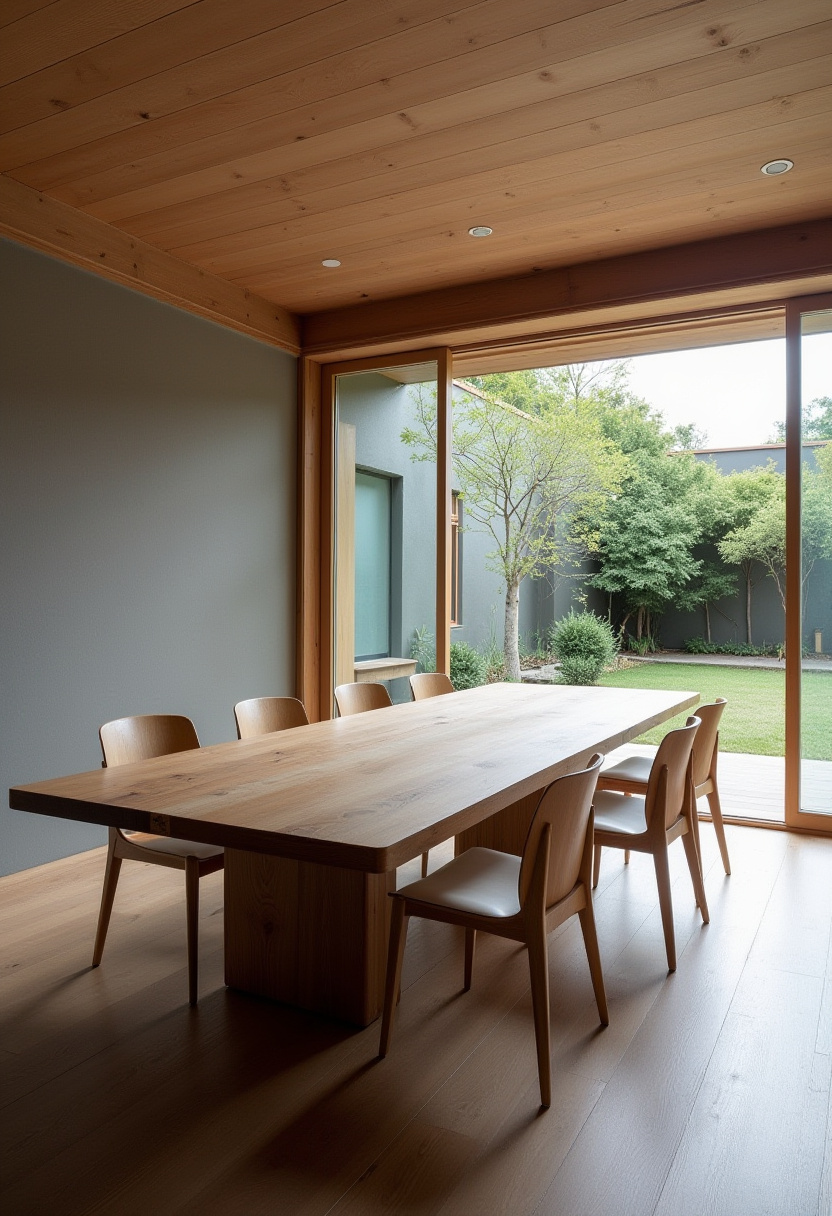
Step into a bright Japandi dining room that feels open and peaceful. A wide teak table made from reclaimed wood stands in the middle, warm and full of charm. Around it, light chairs with slim backs bring air and balance. Large sliding doors open to a quiet garden, letting in light and calm. Soft grey walls and warm wood tones make the space cozy and welcoming. The open design feels free but still warm — a place to talk, eat, and relax. Natural wood and light fabric add warmth and texture. Every part of the room glows with peace and simple beauty.
Choose reclaimed wood for calm, natural style.
Add minimalist chairs for an airy flow.
Use sliding doors to connect with nature.
Keep tones soft and warm for harmony.
4. Modern Concrete Aesthetic
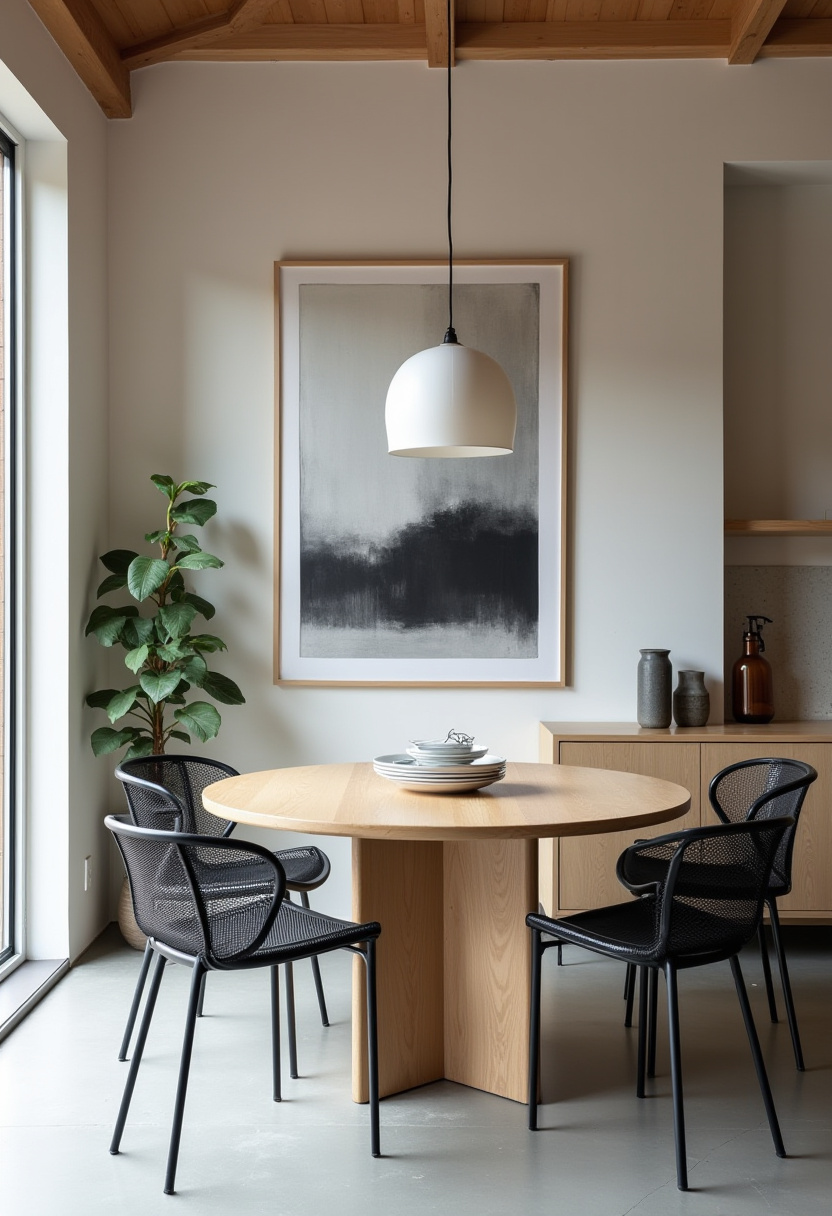
This Japandi dining room feels calm, bright, and modern. A smooth concrete floor adds a clean base, while a light oak table brings warmth and balance. Around it, black metal chairs give a stylish contrast. A green plant near the window adds life and calm. On the walls, large black-and-white art keeps the look simple and bold. Concrete and wood blend softly, creating a cozy, modern mood. The round table makes meals warm and easy to share. With soft light, simple art, and natural plants, the space feels peaceful and full of charm.
Pick a concrete floor for a sleek base.
Use a round oak table to invite talk.
Add black metal chairs for contrast.
Place art and plants for balance and calm.
5. Scandinavian Influenced Serenity
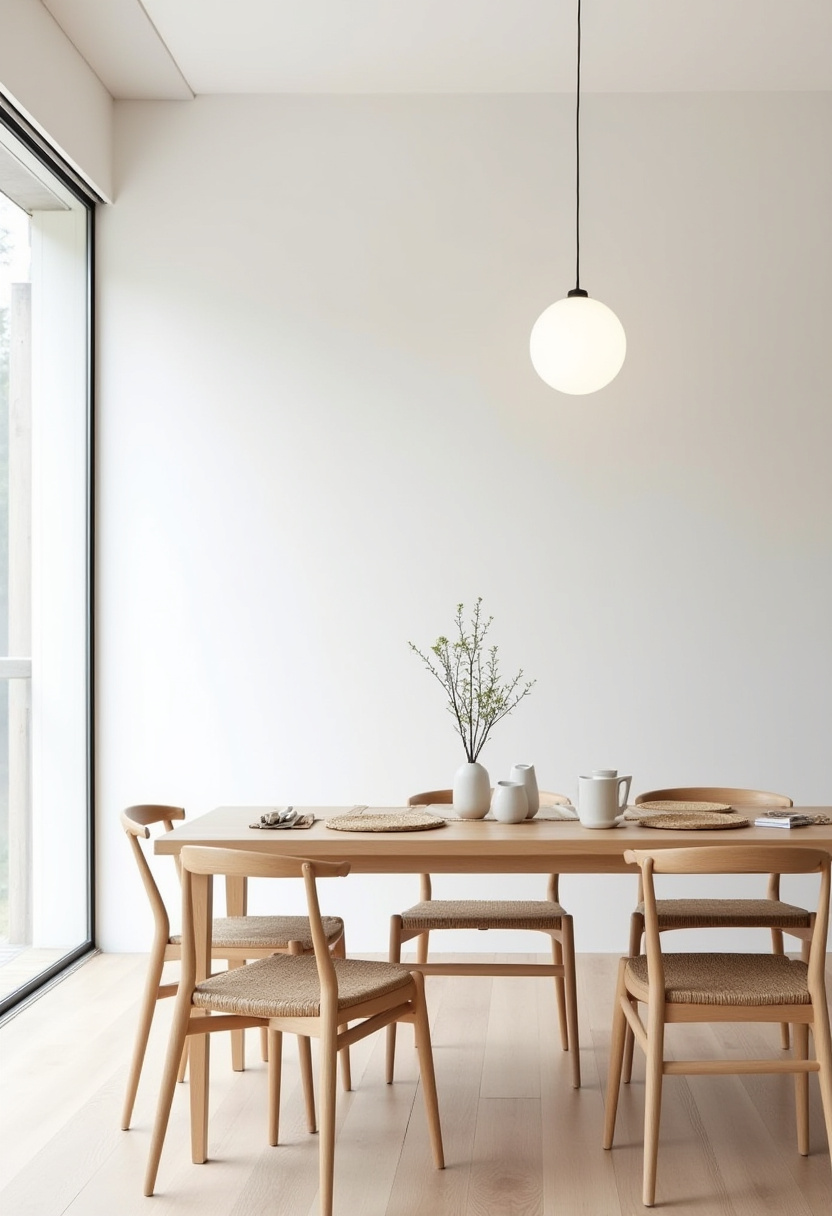
This Japandi dining room feels bright, calm, and full of warmth. White walls open up the space and fill it with light. A blond wood table and chairs bring a soft glow and natural touch. Simple pendant lamps above give a gentle light. A sliding shoji divider adds quiet beauty and a hint of culture. Woven bamboo mats and linen runners bring texture and warmth under soft tones of wood and white. The space feels cozy, simple, and open — perfect for meals and quiet time.
Choose white walls to keep the space light.
Add blond wood furniture for warmth.
Use a shoji divider for a calm look.
Include woven details for a soft, natural feel.
6. Modular Dining Solutions
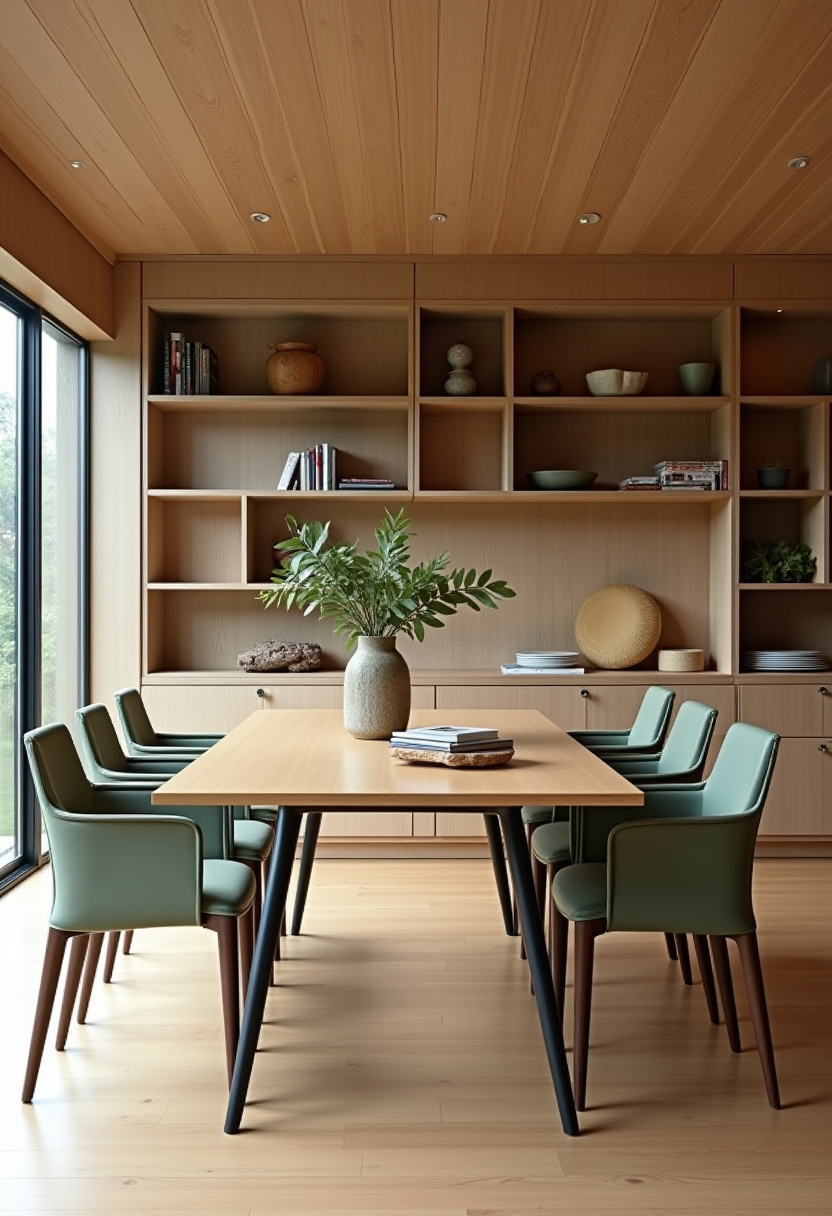
This Japandi dining room feels bright, calm, and full of life. A modular table with foldable sides suits both small dinners and big family meals. Soft sage green chairs are easy to stack and bring cozy comfort. Built-in shelves with simple shapes add charm and extra space for décor. Sunlight shines through wide windows, filling the room with warmth and peace. The look mixes comfort and function — simple, natural, and flexible. Warm tones, wood, and soft light make it feel fresh and soothing. It’s a perfect spot for meals, talks, or quiet evenings.
Pick a modular table for smart use of space.
Add green chairs for comfort and balance.
Use open shelves for style and order.
Let sunlight fill your room with calm beauty.
7. Lofty Compact Charm
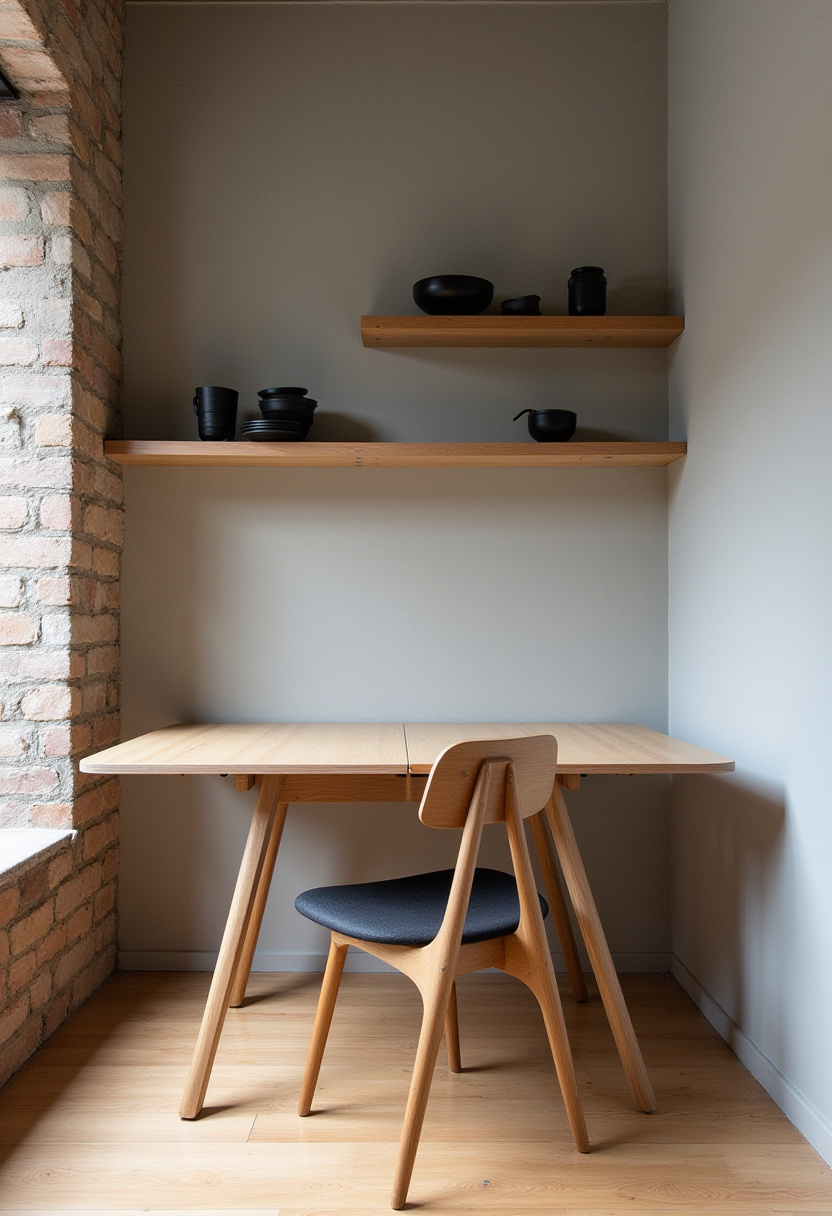
This compact Japandi dining room blends style with smart living. A wall-mounted drop-leaf table saves space and looks clean. Folding chairs fold flat when not in use. Floating shelves with simple ceramics add calm detail and warmth. A soft grey brick wall gives texture and ties the look together. It brings a gentle balance of light and natural tone. Each piece here shows that small spaces can still feel open and relaxing. The drop-leaf table adds flexibility, and the ceramics bring soft charm to the room.
Pick a wall table to save space.
Use folding chairs for easy storage.
Add small ceramics for a cozy touch.
Choose soft grey walls for peace and warmth.
8. Open-Plan Fluidity
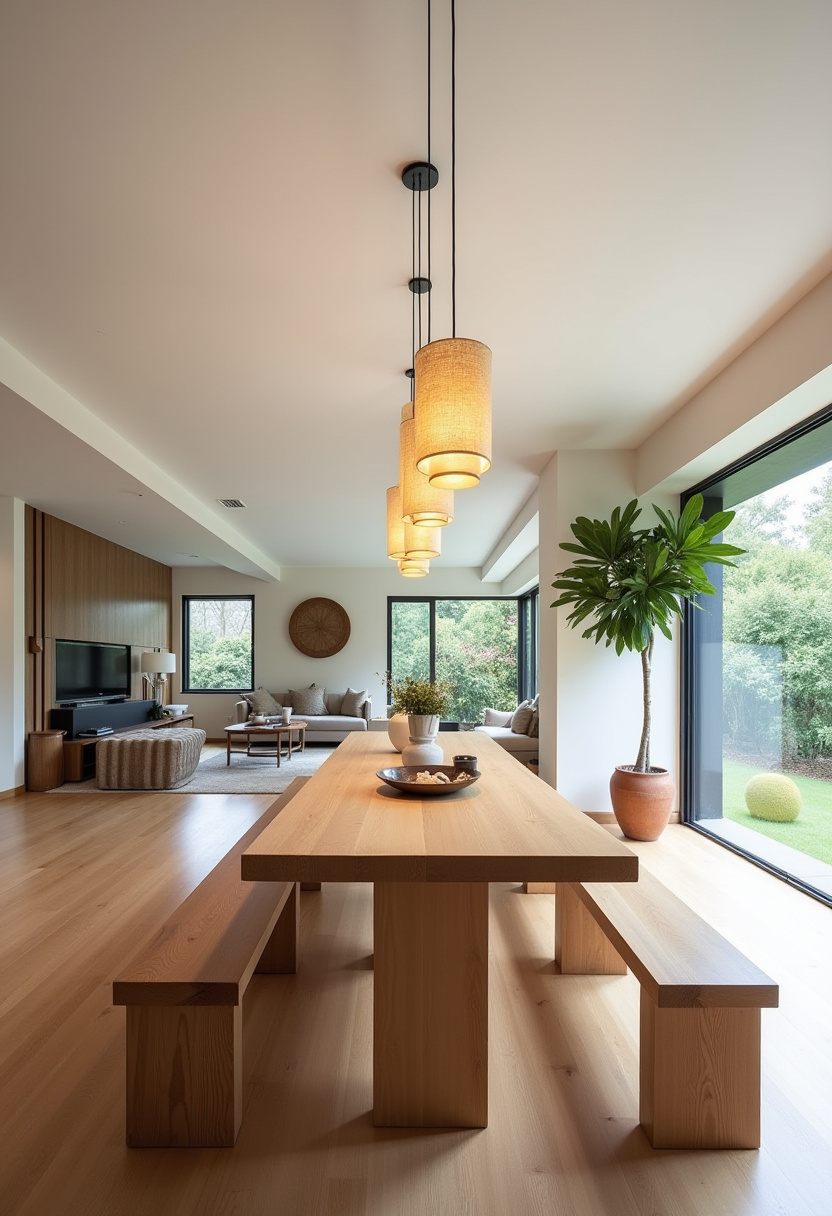
This Japandi dining area flows smoothly into the living room. A long wooden table with benches makes it perfect for eating together. Above, soft pendant lamps with paper shades glow gently. Green plants around the room bring life and a peaceful touch. The mix of white, beige, and warm wood tones feels bright and calm. The open layout keeps people connected and makes daily meals feel warm and easy. Natural wood, soft light, and green leaves blend to create harmony, comfort, and quiet style.
Pick a long wood table for family meals.
Add soft pendant lights for calm lighting.
Place large plants for freshness.
Keep colors soft and natural for peace.
9. Rustic Organic Harmony
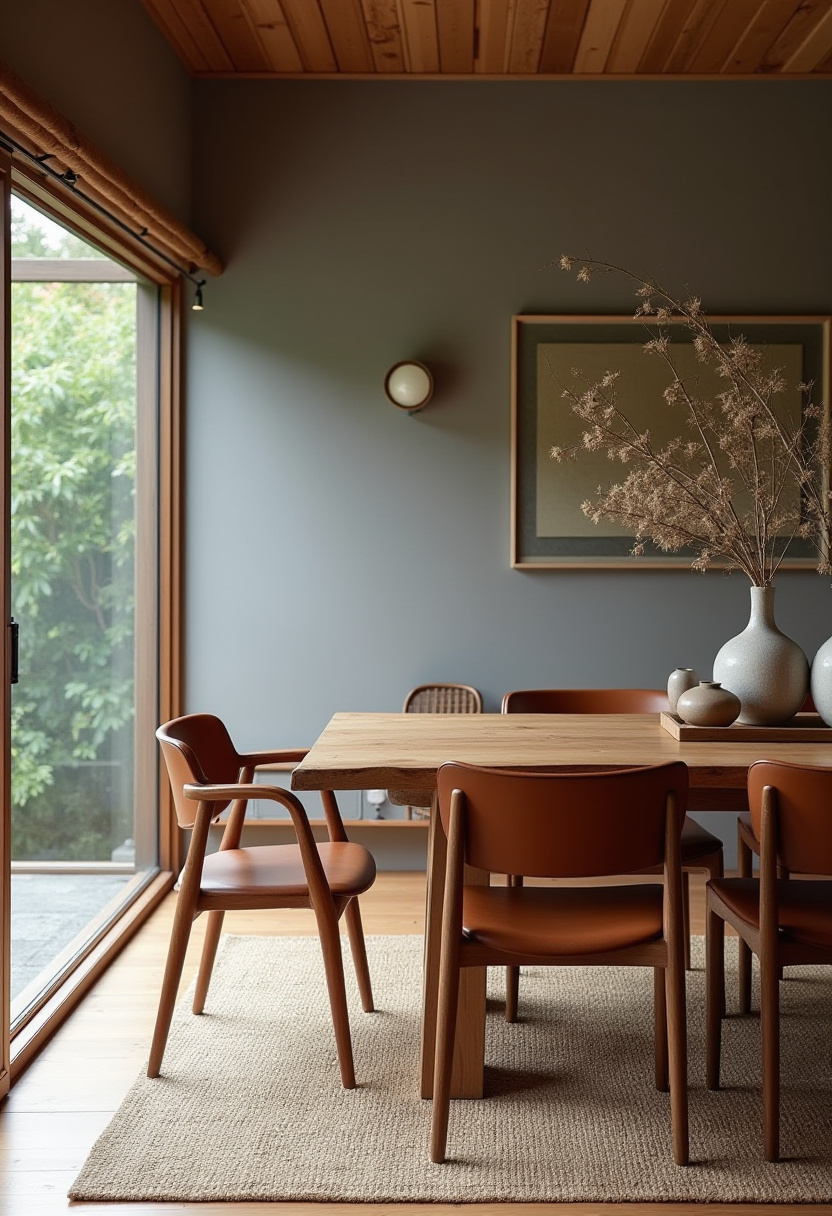
Step into a cozy Japandi dining room filled with natural charm. A live-edge wood table sits at the center, rich in texture and warmth. Around it, leather chairs add comfort and a touch of style. A wide window opens to a quiet garden view, where soft sunlight flows in. Simple ceramic vases rest on the table, adding calm beauty. Grey walls and a woven rug tie the space together with a soft, cozy feel.
This room shows how rustic charm and Japandi peace blend beautifully. Wood, leather, and light work together to create calm and warmth.
Choose a live-edge table for a bold, natural touch.
Add leather chairs for comfort.
Let soft sunlight brighten the space.
Keep decor simple for balance and flow.
10. Minimalist White Serenity
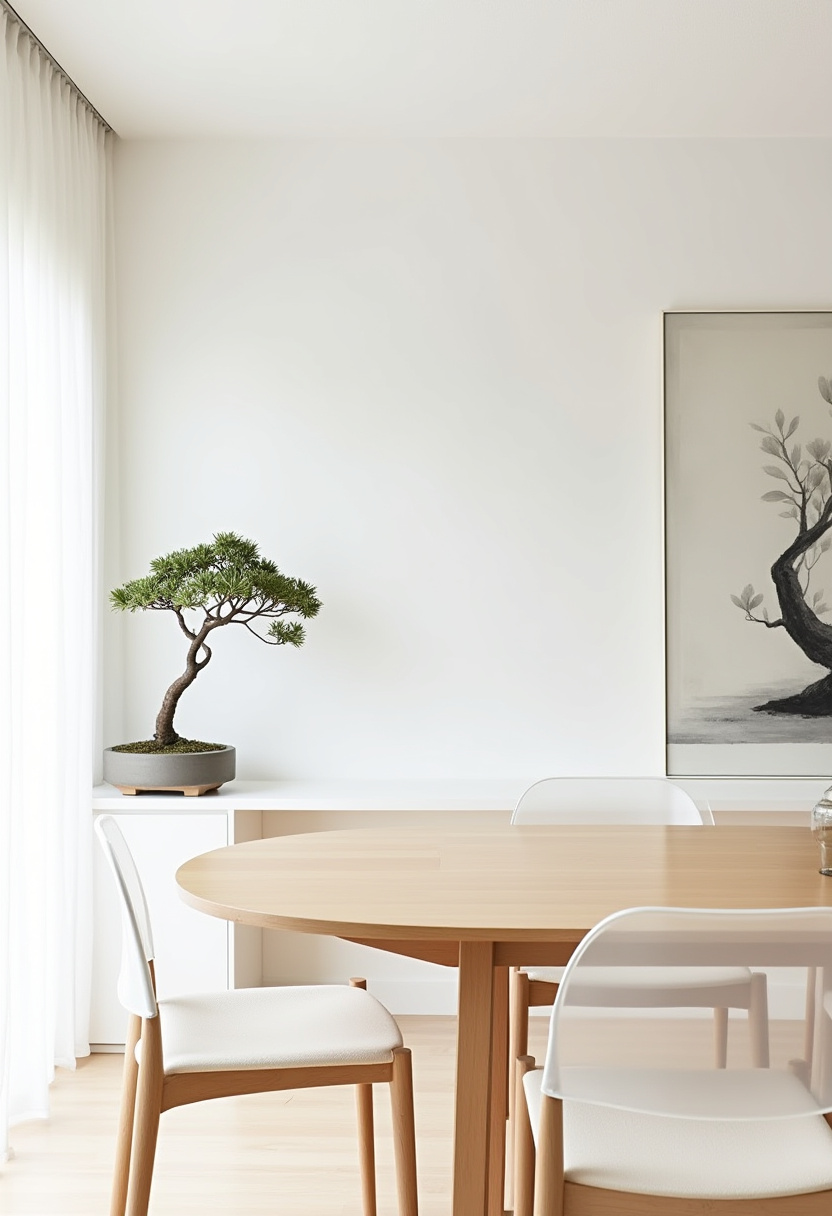
This Japandi dining space feels fresh, bright, and calm. White walls spread light through the room, making it wide and open. A maple wood table brings warmth and life, while soft chairs with paper-like backs add a clean, modern touch. On the wall, a bold black-and-white art piece catches the eye. Beside it, a small bonsai adds a touch of nature and peace. The blend of white and light wood gives balance and comfort — perfect for relaxed meals or quiet mornings.
Choose white walls to keep the room glowing.
Pick a maple table for warmth.
Add soft chairs for calm style.
Place a bonsai for natural beauty.
11. Urban Industrial Influence

This Japandi dining room mixes modern city design with calm, natural warmth. Smooth concrete floors give the space a clean base. A slim ash wood table adds a soft, bright tone. Black metal chairs give contrast and style to the look. Large glass doors open to nature, letting in light and air. A small green plant by the window brings life and softens the modern touch. Wood, metal, and concrete balance each other, making the room feel fresh, open, and warm.
Choose concrete floors for a clean, modern edge.
Add an ash wood table for gentle warmth.
Pick black chairs for a bold accent.
Place plants for freshness and calm.
12. Coastal-Inspired Calm
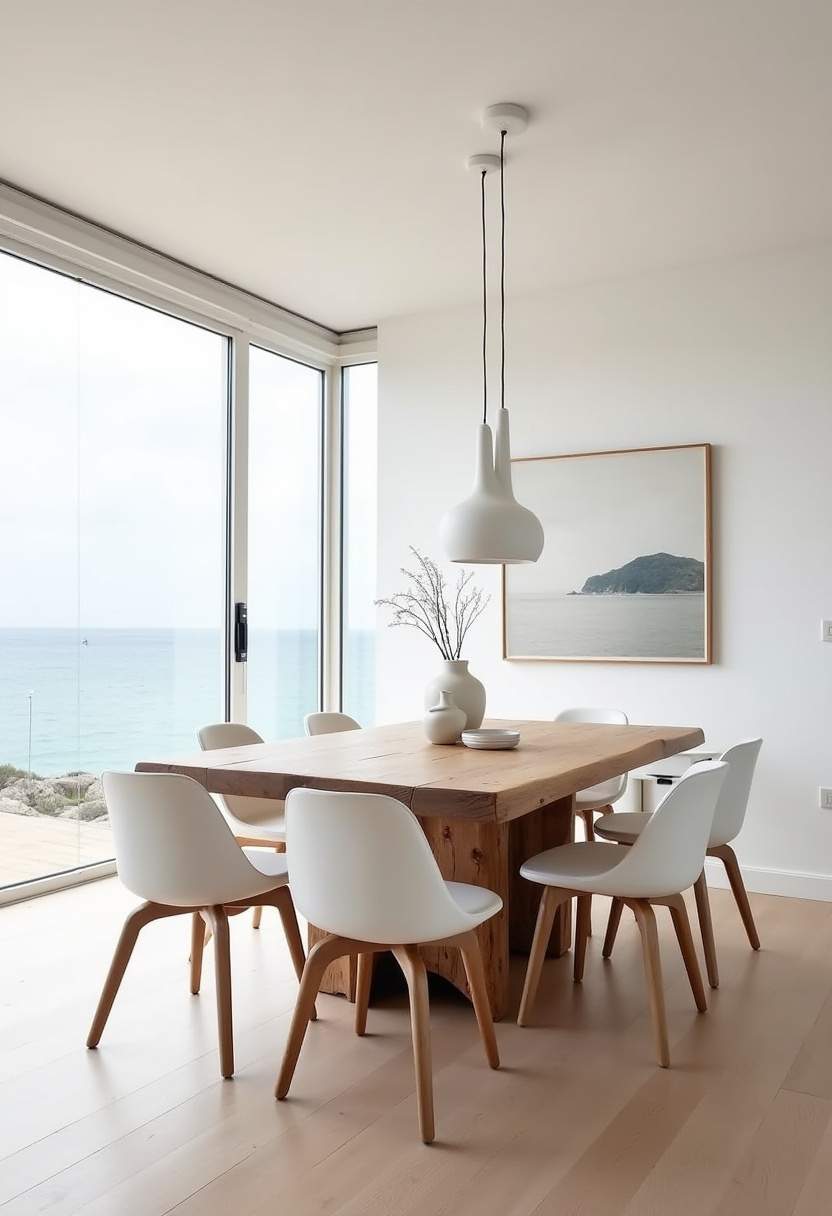
This Japandi dining room feels bright, open, and peaceful. A driftwood table sits in the center, adding warmth and texture. White ceramic chairs surround it, blending softly with the wood. Large windows bring in sunlight and peaceful ocean views. Simple wall art keeps the space light and calm. Soft shades of white and grey create an easy, airy mood. The mix of driftwood, sunlight, and gentle tones gives the room a calm, natural energy — perfect for rest and quiet meals.
Use driftwood for natural warmth.
Add white chairs for clean flow.
Let big windows fill the room with light.
Keep art simple for harmony.
13. Built-In Bench Convenience
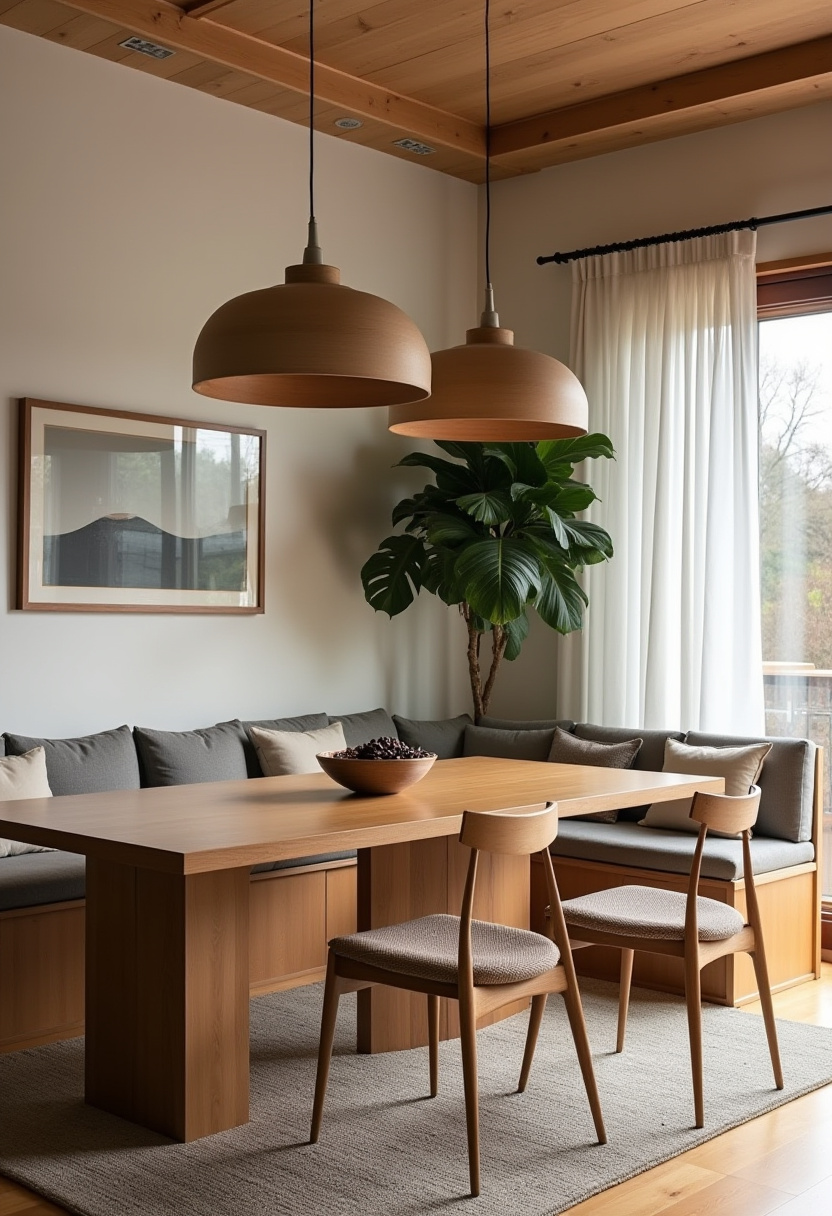
This Japandi dining room feels bright, simple, and full of warmth. Built-in benches line the walls, saving space and adding comfort. A wooden table sits neatly in the center, bringing balance to the look. Above, soft ceramic lights give a warm, calm glow. A neutral rug adds texture, and a tall plant brings fresh life to the room. Each piece adds ease, purpose, and harmony. Wood, light, and greenery work together to form a cozy and peaceful space — perfect for sharing meals or relaxing with family.
Choose built-in benches for comfort.
Pick a wooden table for clean design.
Use soft pendant lights for warmth.
Add a green plant for freshness.
14. Space-Saving Studio Solutions
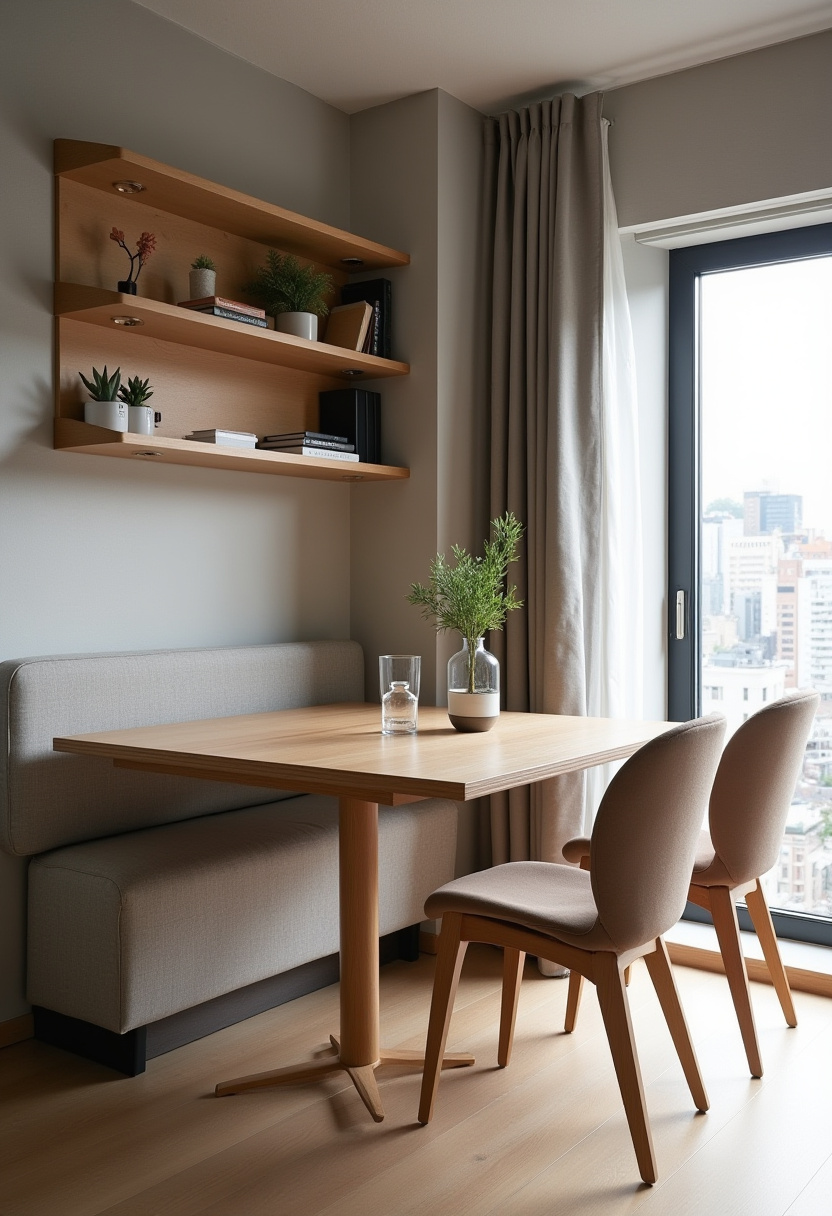
This Japandi dining room feels cozy, bright, and modern. A folding wall table saves space and looks stylish at the same time. Stackable chairs in warm earth tones bring comfort and store easily. Floating shelves display simple pieces that keep the room light and neat. Soft grey walls add depth and calm, making it feel peaceful and full of charm. Every piece has meaning — the folding table adds use, the chairs add ease, and the shelves keep it open and airy. It’s a beautiful mix of warmth and clean design.
Use a folding wall table to save space.
Pick stackable chairs for comfort.
Add floating shelves for charm.
Paint walls in soft grey to feel calm.
15. Round Wooden Harmony
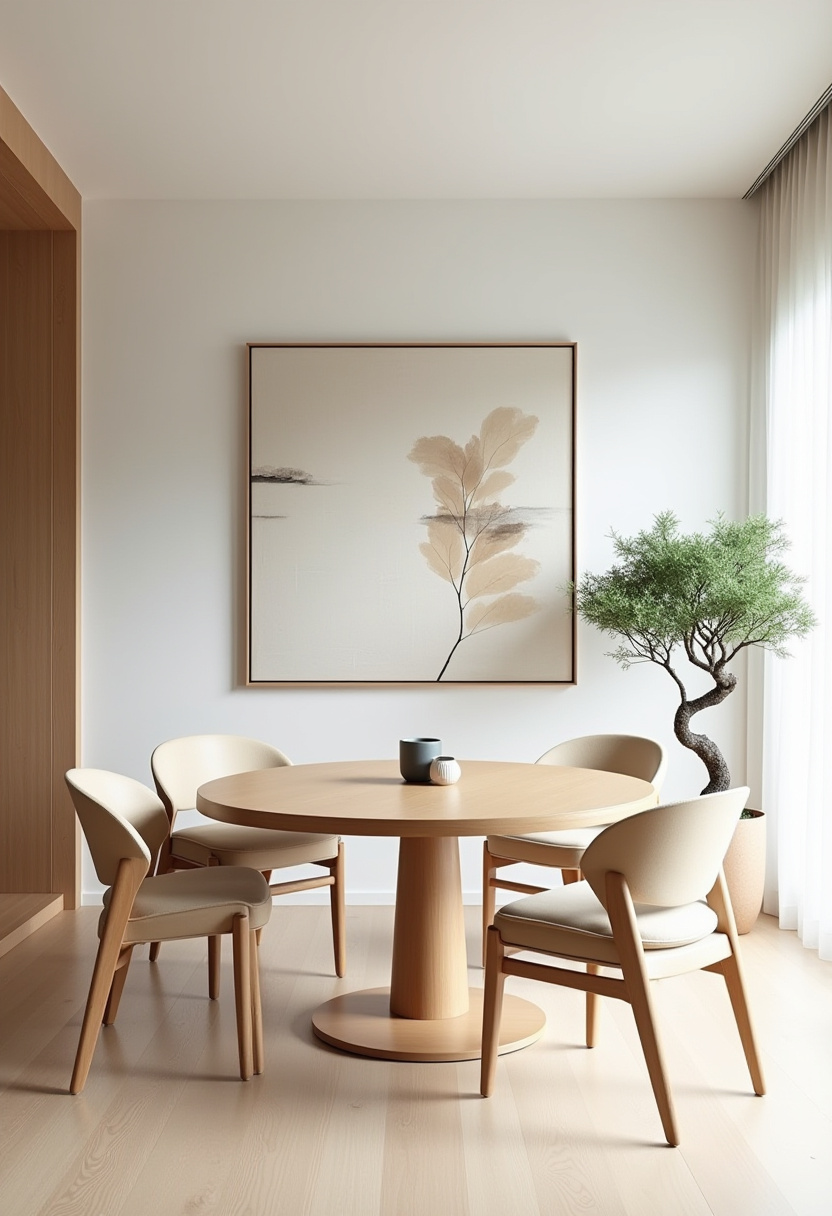
This Japandi dining room feels soft, bright, and peaceful. A round wood table stands in the center, inviting easy talks and warm meals. Chairs with light, paper-style backs add a clean, modern touch. A large abstract artwork hangs on the wall, adding focus without crowding the space. Soft white shades and warm wood tones make the room calm and cozy. The soft lines and natural colors create balance and warmth. It’s the perfect space for quiet dinners and mindful moments with loved ones.
Choose a round table for closeness.
Pick modern chairs for comfort.
Add large art for beauty.
Keep colors neutral for peace.
16. Modern Zen Escape

This Japandi dining room feels calm, warm, and full of light. Smooth concrete floors keep the look clean and modern. A long wooden table sits in the center, inviting family and friends to gather. Black metal chairs add a touch of edge and style. Wide glass doors open to a quiet garden, letting in air and sun. Simple ceramic vases and green plants soften the space and bring nature indoors. Wood, metal, and concrete work in balance, creating a cozy and open mood. The design flows gently between home and garden — a perfect spot for peace and togetherness.
Use concrete floors for a modern touch.
Pick a wooden table for connection.
Open sliding doors to bring light inside.
Add plants and ceramics for calm beauty.
17. Scandinavian Elegance
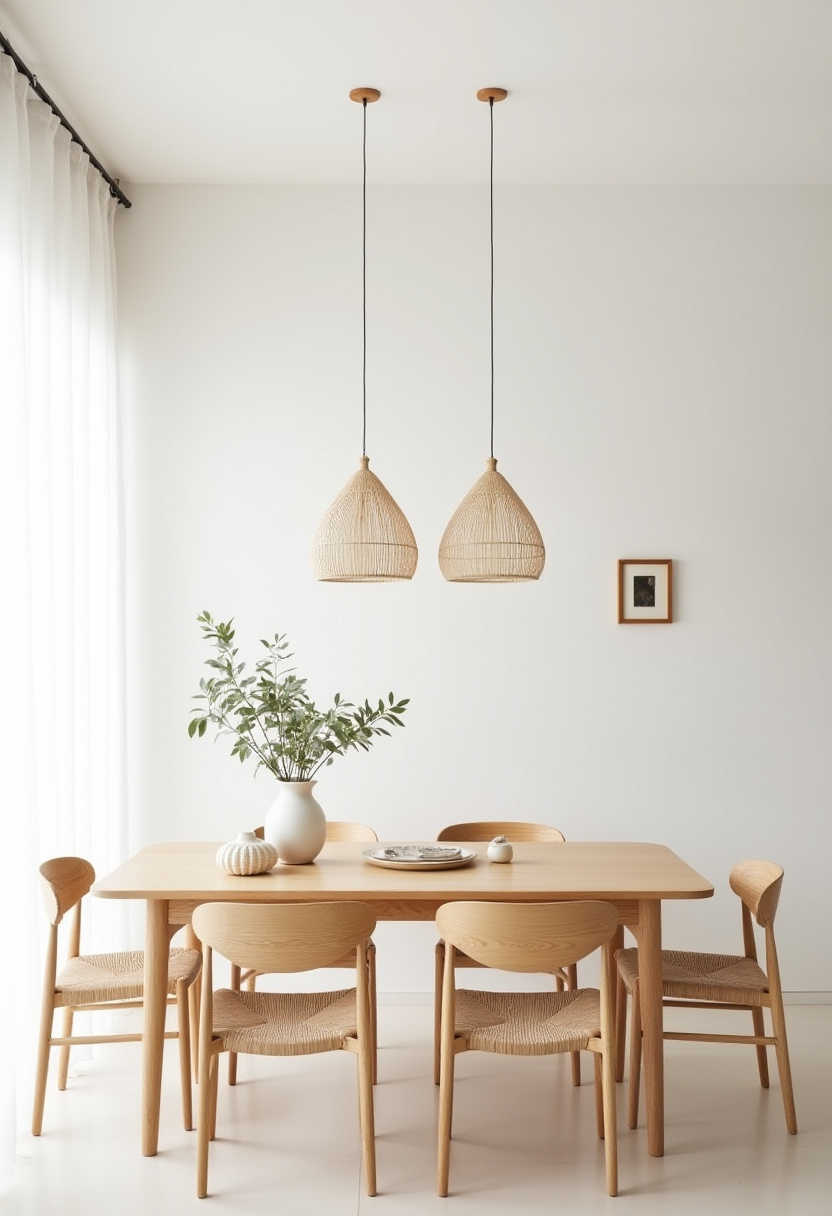
This Japandi dining space feels bright, soft, and full of calm. White walls open up the room, letting light flow freely. A blond wood table and chairs add warmth and a natural touch. Soft pendant lights with paper shades give a gentle, warm glow. A shoji divider brings charm and adds a quiet, cultural feel. Woven pieces, like mats and rugs, make the space cozy and relaxed. The mix of white and wood feels fresh and peaceful — perfect for meals, talks, or quiet reflection.
Use white walls for a bright, airy space.
Add blond wood furniture for warmth.
Include a shoji divider for beauty.
Use woven pieces for a soft, natural feel.
18. Rustic Elegance Reimagined
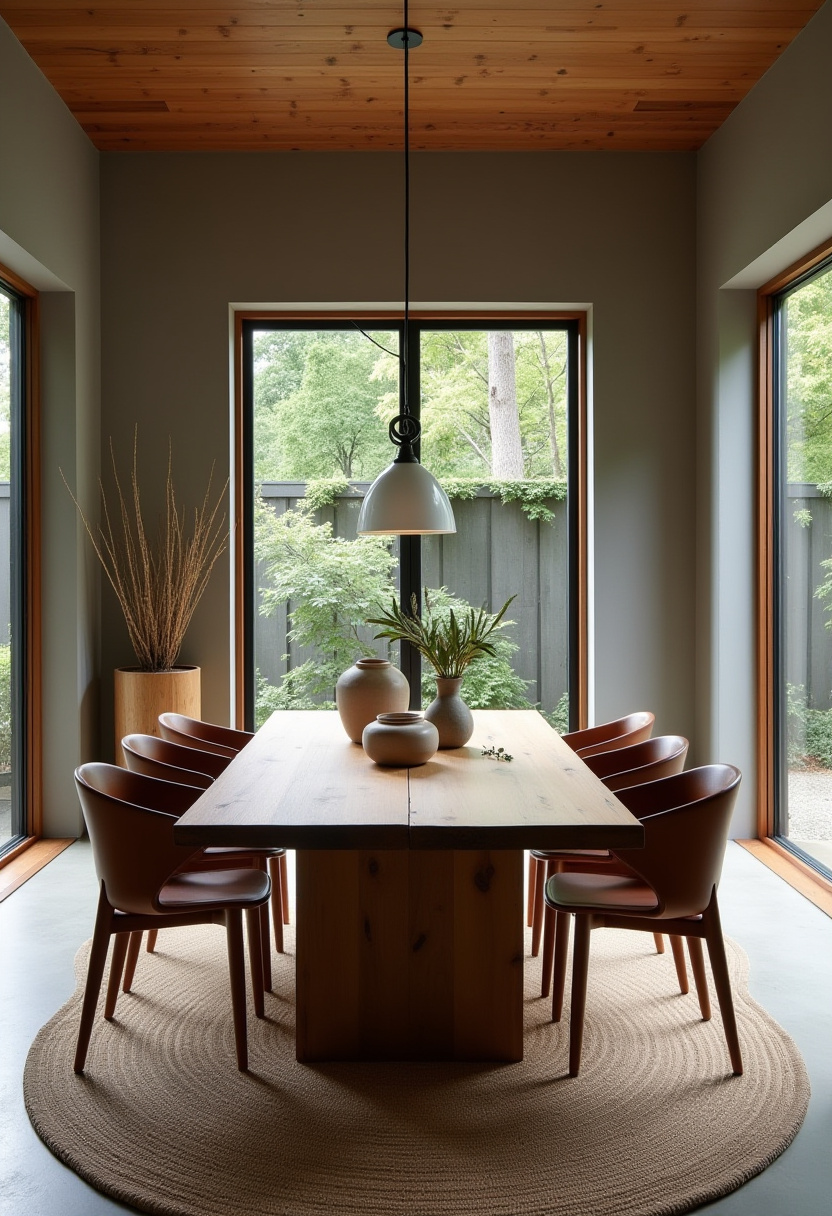
This cozy Japandi dining room blends rustic charm with simple beauty. A live-edge wooden table stands in the middle, full of texture and warmth. Around it, leather and wood chairs add comfort and style. A large window opens to a quiet garden and fills the room with light. Small ceramic pieces bring soft elegance. Pale grey walls and a woven rug make the space feel calm and natural. Each detail adds peace and warmth, creating a bright spot for shared meals and quiet moments.
Choose a live-edge table for a natural feel.
Add wood and leather chairs for comfort.
Include a large window for light and space.
Use simple ceramics to keep it balanced.
19. Urban Compact Solutions
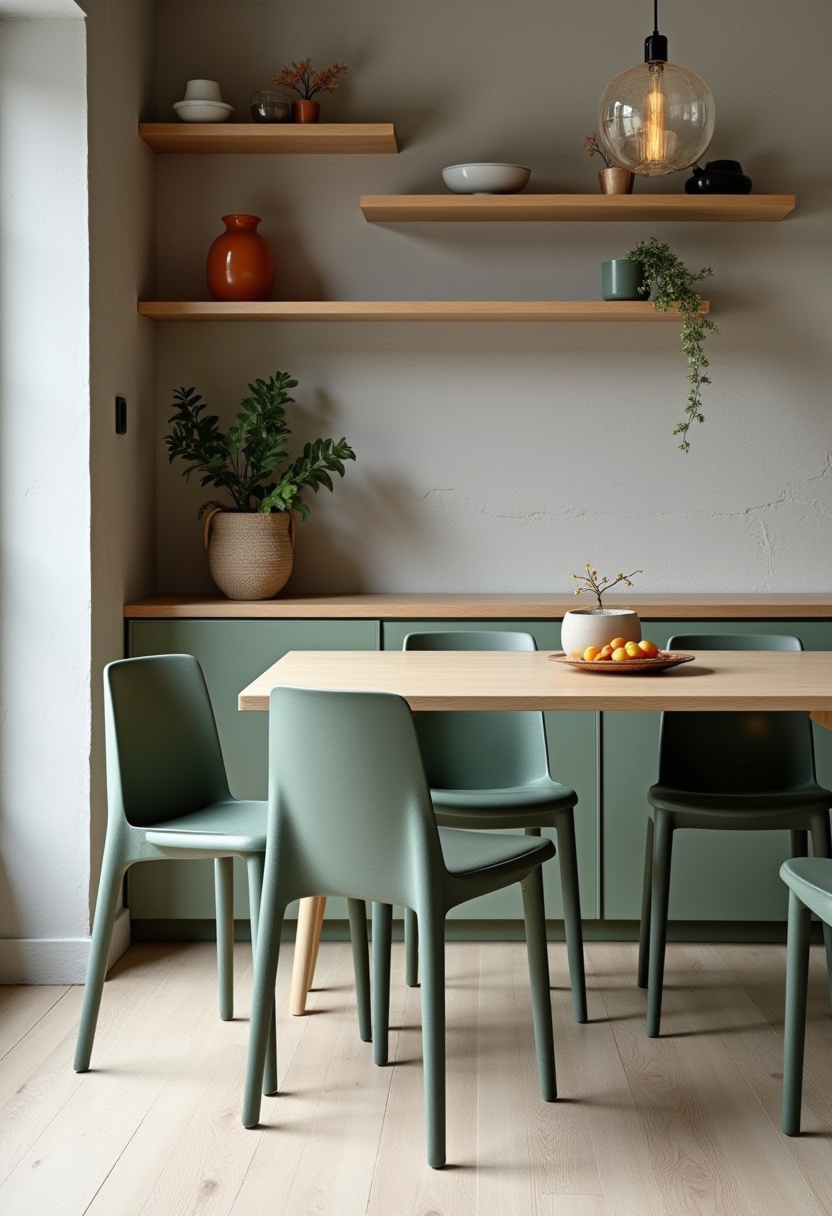
This Japandi dining area feels bright, smart, and full of ease. A modular table changes size to fit any meal. Soft sage green chairs stack away easily and add cozy color. Built-in shelves hold storage and decor while saving space. A grey brick wall warms the look and gives it modern charm. Wood, brick, and soft colors mix for a calm, stylish feel — simple and peaceful, yet full of function. It’s ideal for small homes that want beauty and balance.
Use a modular table to save space.
Add stackable chairs for comfort.
Try built-in shelves for style and order.
Paint walls soft grey for warmth.
20. Open-Plan Harmony
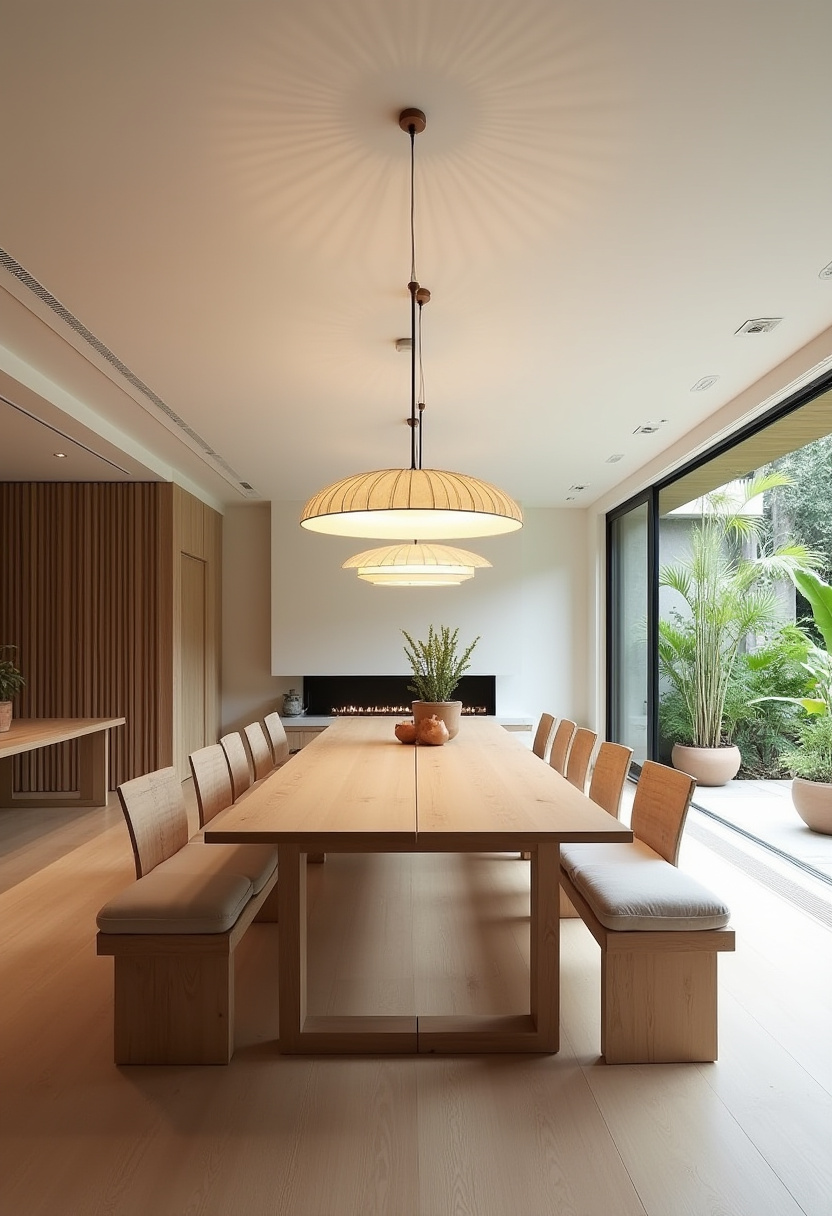
This Japandi dining space feels calm, bright, and full of ease. A long wood table with bench seating invites warm talks and shared meals. Soft pendant lights with paper shades cast a gentle glow. Green plants add life and bring nature indoors. Whites, beiges, and pale wood tones make the space open and light. The flow feels easy and balanced — ideal for cozy dinners and friendly gatherings. Natural wood and soft light mix to form peace and comfort.
Choose a long wood table for connection.
Add soft pendant lamps for glow.
Place green plants for a fresh touch.
Use neutral tones for calm beauty.
Japandi style joins simple design with warmth and care — creating a dining space that feels clean, relaxing, and full of harmony.

